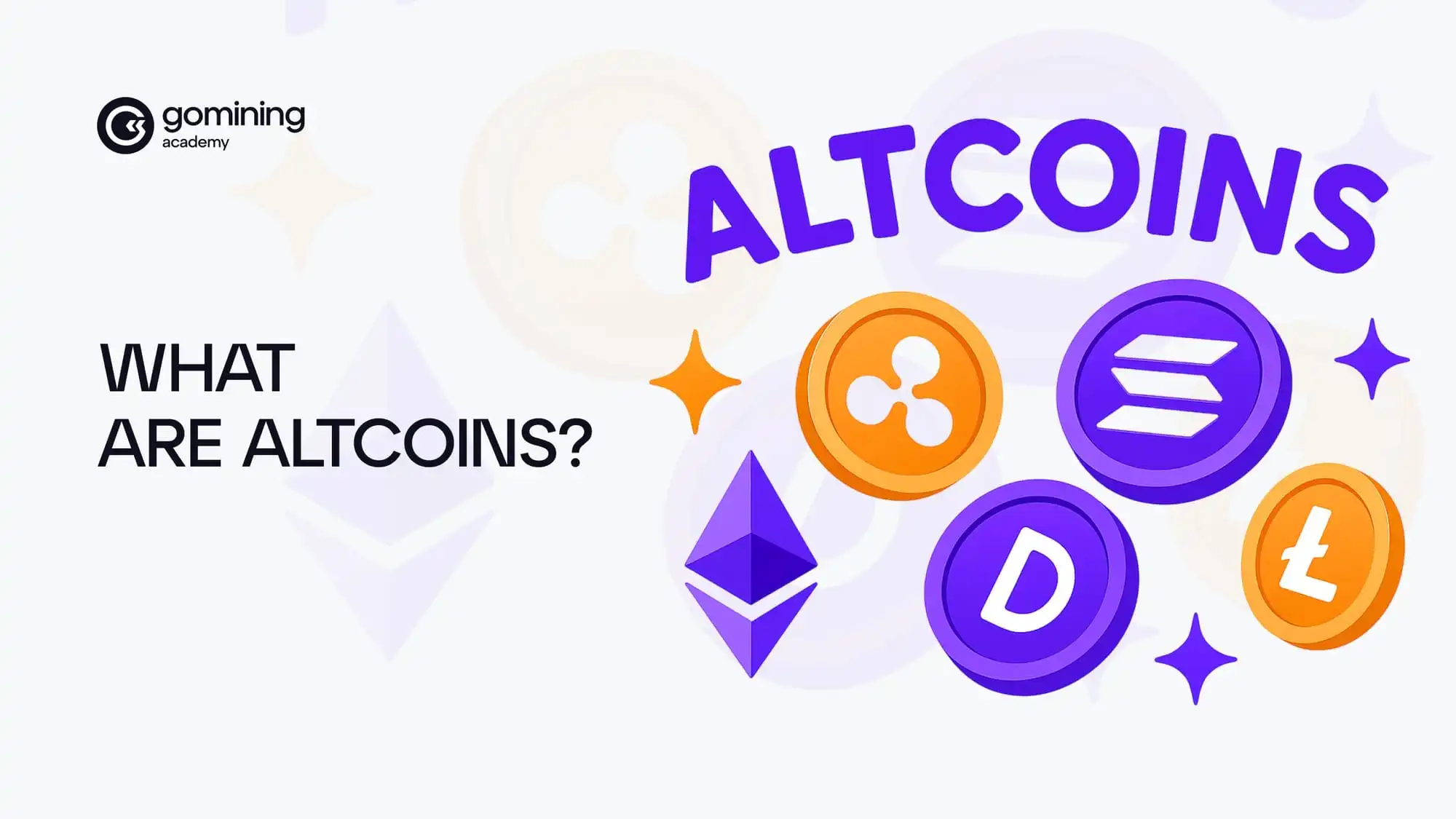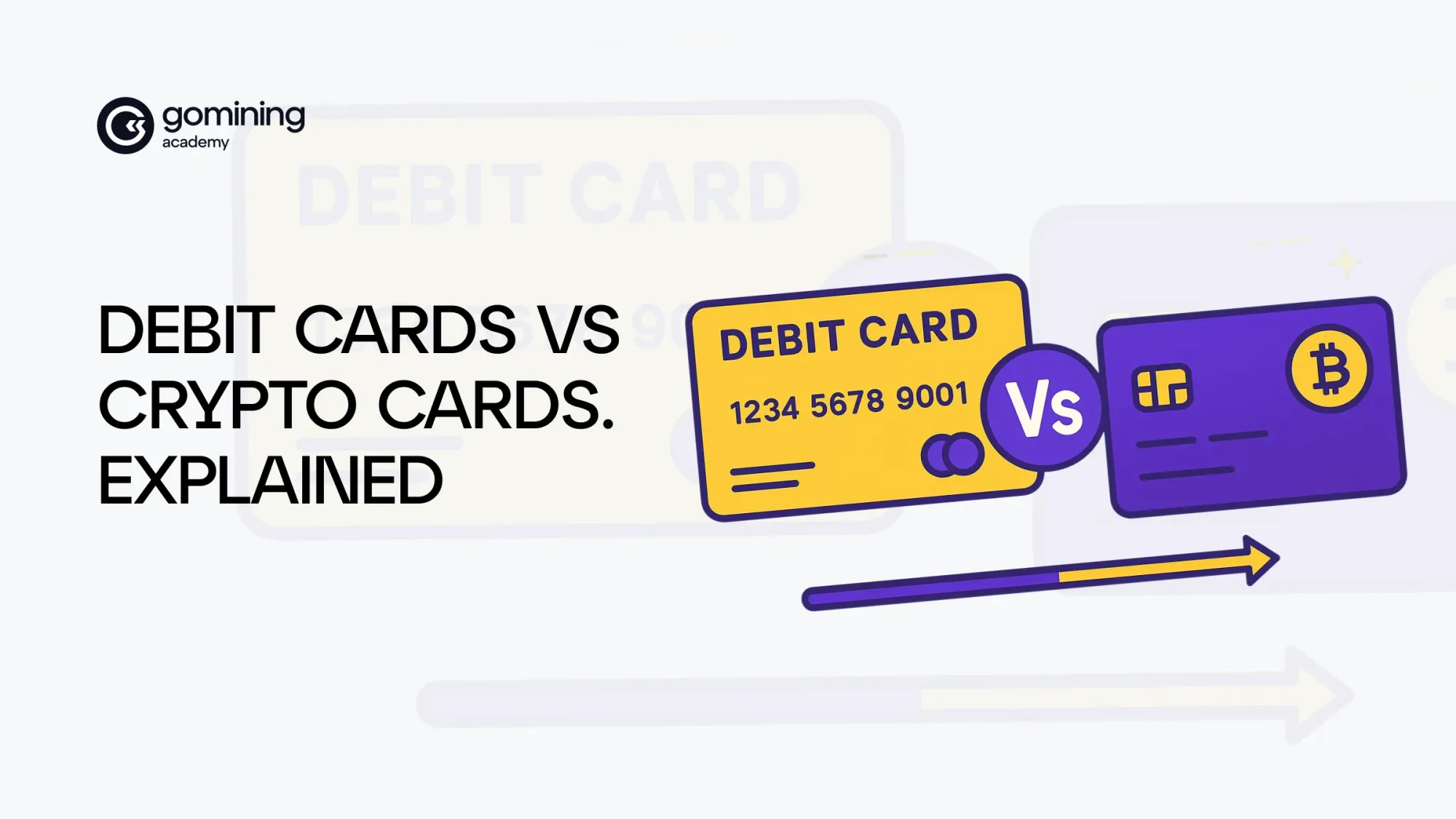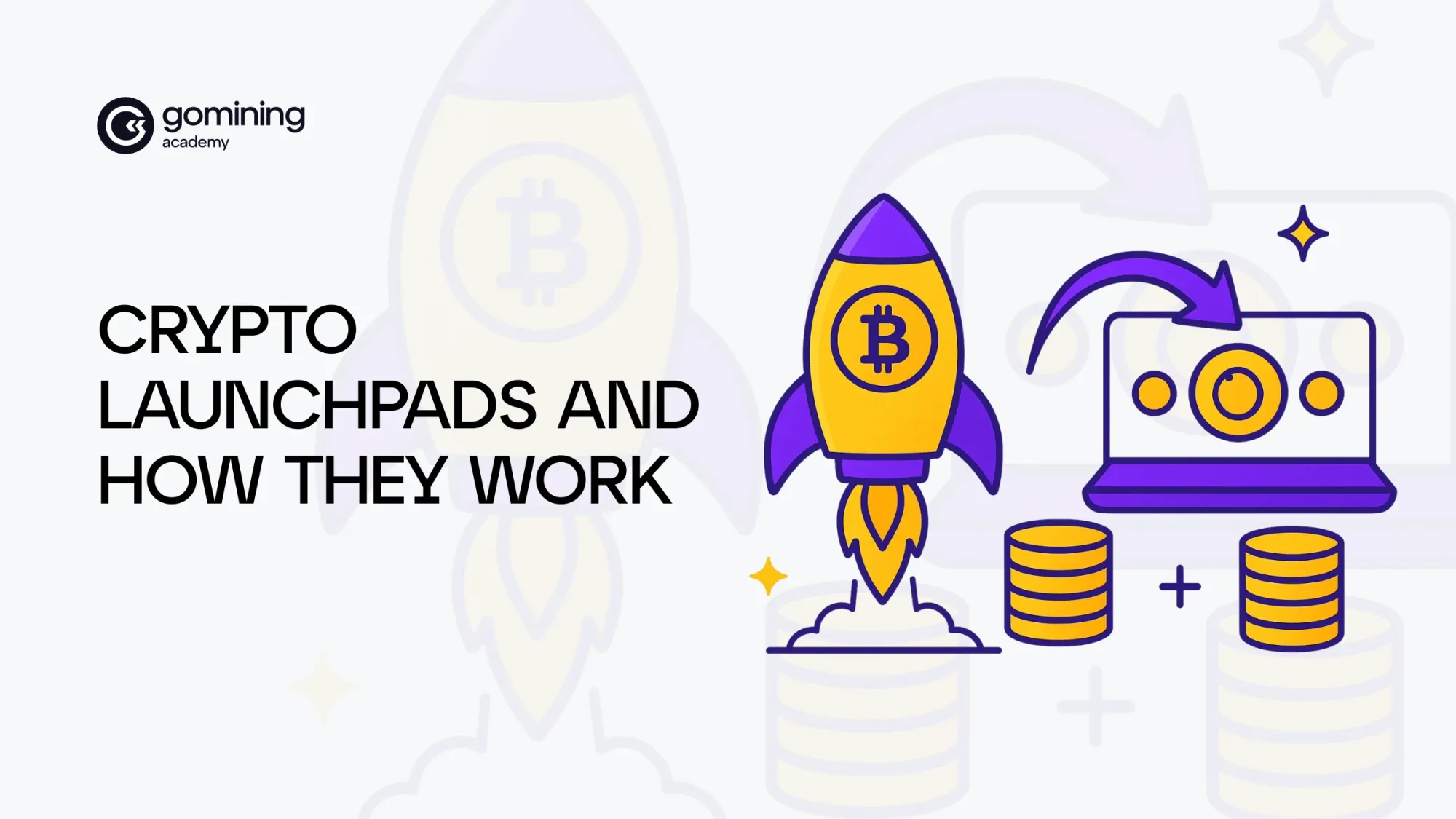What are Altcoins?

Cryptocurrencies have completely changed how we think about money and value in the digital age. Most people know about Bitcoin, the original cryptocurrency, but there’s a whole universe beyond it. So, what are Altcoins exactly?
Table of Contents:
- How Altcoins Differ from Bitcoin
- Types of Altcoins
- What Are the Use Cases For Altcoins
- Risks of Altcoins
- Popular Altcoins
- How to Buy Altcoins
- The Future of Altcoins
- Discover GoMining’s Token Ecosystem
- Conclusion
Altcoins, short for “alternative coins,” are basically any cryptocurrencies that are not Bitcoin. They were created as alternative cryptocurrencies to offer new features, solve Bitcoin’s limitations, or cater to different use cases.

Why do these alternatives exist? Bitcoin set the stage as the first successful decentralized digital money. Yet, it has certain restrictions — like slower transaction speeds and limited programmability — that inspired developers to design other coins with enhanced functionalities. Altcoins fill these gaps and broaden the possibilities of blockchain technology, helping the ecosystem become more diverse and innovative.
These digital assets hold an important position in the expanding world of crypto. Beyond just being substitutes, they form a vital part of the cryptocurrency market by enabling specialized functions such as smart contracts, privacy, stability, and community engagement. For anyone beginning to explore the crypto space or considering a broader portfolio, understanding altcoins is essential.
How Altcoins Differ from Bitcoin
While Bitcoin was the trailblazer, many coins that followed bring unique technical characteristics and goals.
Key differences in technology
Bitcoin’s primary purpose is to act as a decentralized currency and store of value, secured by a proof-of-work mechanism. Many other cryptocurrencies have introduced improvements or different consensus algorithms like proof-of-stake, which can be more energy-efficient. Some altcoins offer faster confirmation times or more complex scripting capabilities.
For example, Ethereum (ETH) introduced a programmable blockchain that allows developers to build decentralized applications (dApps) and execute complex contracts automatically. Others focus on enhancing user privacy or enabling cross-chain interactions, highlighting a wide variety of technological experiments in the crypto field.
Purpose and Use Cases of Altcoins
Not all altcoins aim to be direct Bitcoin competitors. Many serve specific niches:
- Some provide price stability by pegging their value to fiat money, helping users avoid the wild fluctuations common in cryptocurrencies.
- Others enable anonymous transactions, protecting users’ identities and financial details.
- A few are designed as platforms to host entire ecosystems of decentralized finance or gaming apps.
- Then there are coins created mostly for fun or as social experiments, which nonetheless have developed passionate followings.
Market Capitalization and Popularity Comparison
Bitcoin remains the largest and most well-known cryptocurrency, often referred to as “digital gold.” However, several altcoins have grown hugely in value and adoption, frequently ranking high in market capitalization. Coins like Ethereum, Ripple (XRP), and Litecoin have carved out significant roles, proving that Bitcoin’s alternatives are no longer fringe projects but major players in the digital currency landscape.
Types of Altcoins
The world of alternatives to Bitcoin is vast and varied, reflecting the many ways blockchain technology can be adapted to different needs and goals. Understanding the different altcoin types is essential for anyone exploring the crypto ecosystem. Here are some key categories you should know:
Bitcoin Forks
A common way new cryptocurrencies emerge is through what’s called a fork. In blockchain terms, a fork happens when developers take the original Bitcoin software’s codebase and create a new version by making changes — sometimes minor, sometimes substantial. These forks typically arise because groups within the community disagree on technical or ideological issues.
Forks often aim to address limitations or challenges found in Bitcoin. For example, Bitcoin’s transaction speed and network congestion have been ongoing topics of discussion. Some developers believe increasing the block size — the amount of transaction data each block can hold — can help process more transactions faster and at lower fees.
Two of the most well-known forks are:
- Bitcoin Cash (BCH): Launched in 2017, Bitcoin Cash increased the block size from 1MB to 8MB initially, later expanding it further. This was designed to allow the network to handle more transactions per second, making it more practical for everyday payments. BCH proponents focus on Bitcoin’s original vision as a peer-to-peer digital cash system.
Bitcoin SV (BSV): Short for “Bitcoin Satoshi Vision,” BSV split from Bitcoin Cash in 2018. It aims to restore what its developers consider the original Bitcoin protocol as envisioned by Satoshi Nakamoto, focusing on scaling the blockchain massively with very large blocks, and emphasizing stability and security.

Although these forks share much of Bitcoin’s core technology, such as proof-of-work consensus, similar mining mechanisms, and blockchain architecture — they differ significantly in philosophy, technical parameters, and community support. Forks allow the cryptocurrency market to experiment with different approaches to decentralization, scalability, and use cases while preserving Bitcoin’s foundational design.
Other less-known forks also exist, each with its own tweaks and objectives, contributing to the rich diversity of Bitcoin alternatives. By understanding forks, stakeholders and enthusiasts gain insight into how blockchain innovation evolves through collaboration and sometimes contention.
Ethereum-Based Tokens (ERC-20)
Ethereum’s blockchain supports a standard called ERC-20, which allows anyone to create their own token that runs on top of Ethereum’s network. This has led to an explosion of tokens used for a variety of purposes such as decentralized finance, gaming, and governance. These tokens benefit from Ethereum’s security and smart contract capabilities without requiring their own blockchain.

Stablecoins
Stablecoins like Tether (USDT) and USD Coin (USDC) are digital currencies designed to maintain a stable value by being pegged to traditional currencies like the US dollar. These coins provide an essential function in the crypto world by enabling traders and users to escape price volatility while remaining within the blockchain ecosystem.

Privacy coins
Not everyone wants their transactions visible on a public ledger. Privacy-focused cryptocurrencies such as Monero and Zcash use advanced encryption to keep sender, receiver, and transaction amounts confidential. These coins appeal to users who prioritize financial privacy and anonymity.
Platform coins
This group includes cryptocurrencies that power blockchain platforms designed for applications beyond simple payments. Ethereum (ETH), Cardano (ADA), and Solana (SOL) are examples, offering infrastructures for building decentralized apps, smart contracts, and complex financial products.
Meme coins
Originating mostly as jokes or internet memes, coins like Dogecoin and Shiba Inu have surprisingly grown into significant communities and markets. While often lacking serious technical innovation, these coins demonstrate the power of social media and community in shaping crypto value.

What Are the Use Cases For Altcoins?
When many in crypto talk about altcoins, they think of “moonshots” and memes that go up 20x in value, only to crash on the same day. While that can technically be a use case for some, it’s not the only reason altcoins can be valuable. Altcoins can open up exciting opportunities and help you leverage valuable ecosystems while on your Bitcoin journey. Here’s how:
Access to New Ecosystems
A number of altcoins (like the GoMining token, for example) are ecosystem utility tokens. They’re designed to give you perks and advantages within the native application of the token.
These “utility tokens” give you the right to vote on project decisions, join a DAO, or make purchases in the ecosystem.
Access to Innovative Blockchain Technologies
Getting involved in altcoins also means supporting and gaining exposure to a wide variety of blockchain innovations. From Ethereum-based tokens that power smart contracts and decentralized apps, to privacy coins that focus on anonymous transactions, each altcoin represents a different facet of the evolving cryptocurrency landscape. This diversity is crucial as the market matures and use cases expand beyond simple digital currency transfers.
Opportunity to Participate in Growing Ecosystems
Many altcoins are part of vibrant communities and ecosystems with active development, governance models, and partnerships. Being part of these ecosystems can sometimes offer benefits beyond price appreciation, such as staking rewards, voting rights, or access to new financial services.
Potential for High Returns
Many alternative cryptocurrencies have experienced rapid price increases due to innovation, hype, or emerging use cases. While they can be more volatile, this volatility can offer higher growth opportunities, especially for participants who carefully research projects and timing.
Risks of Altcoins
Altcoins contribute significantly to the cryptocurrency ecosystem, but there's also a number of risks that have to be mentioned.
Let's zoom in on a few of them.
Market volatility
Alternative cryptocurrencies can have dramatic price swings driven by market sentiment, technology changes, or news events. This volatility can lead to large gains but also sharp losses.
Regulatory challenges
Cryptocurrency regulations remain in flux worldwide. Some governments may impose restrictions or bans on specific altcoins or related activities, which can impact prices and usability.
Risk of scams and frauds
The crypto space, especially among lesser-known altcoins, is unfortunately rife with scams and fraudulent schemes. Participants should exercise caution, verify projects’ credibility, and avoid coins without clear use cases or transparent teams.
Popular Altcoins
Several cryptocurrencies stand out due to their technological advancements, strong communities, and market presence. Here’s a quick breakdown:
Ethereum (ETH): The largest smart contract platform powering countless decentralized apps.
Litecoin (LTC): An early Bitcoin alternative focused on faster transactions and lower fees.
Ripple (XRP): Designed for quick, inexpensive cross-border payments between banks.
Cardano (ADA): A research-driven platform with a focus on scalability and sustainability.
Polkadot (DOT): Enables different blockchains to communicate and work together.
Solana (SOL): Known for high throughput and low-cost transactions, popular for DeFi and NFT projects.
How to Buy Altcoins
Choosing the right cryptocurrency exchange
To enter the world of altcoin trading, you’ll need to select a reputable digital marketplace where these currencies are bought and sold. Consider factors like security, fees, supported coins, and user experience when picking a platform.
Storing Altcoins in Wallets (Hot vs. Cold)
Once you acquire your coins, safe storage is vital. You can keep your assets in altcoin wallets — either hot wallets (connected to the internet and convenient for frequent use) or cold wallets (offline storage for long-term security). The choice depends on your use case and risk tolerance.
The Future of Altcoins
Trends In the Market
Emerging trends like decentralized finance (DeFi), blockchain gaming, and interoperability between different chains are shaping the future landscape for altcoins. These developments promise more usability and integration of crypto into everyday life.
Technological Advancements
Many projects continue pushing the boundaries with innovations such as layer-2 scaling solutions, privacy protocols, and novel consensus mechanisms. These advances improve speed, reduce costs, and increase accessibility.
The Role of Altcoins in Decentralized Finance
Alternative cryptocurrencies are at the heart of DeFi platforms that enable peer-to-peer lending, yield farming, decentralized exchanges, and more, creating a new financial ecosystem independent of traditional banks.
Discover GoMining’s Token Ecosystem
Tokens are at the heart of many blockchain projects, acting as digital assets that power networks, incentivize users, and enable new financial models. One exciting example is the GOMINING token, created specifically to support the future of digital mining and cryptocurrency rewards.
GoMining’s innovative approach combines the power of blockchain with real-world mining operations, allowing users to participate in a transparent and efficient crypto mining ecosystem. By using the GoMining token, participants can enjoy benefits like guaranteed daily Bitcoin rewards, flexible upgrades, and access to a growing network of miners — all managed securely through blockchain technology.
This token is designed to bridge the gap between digital assets and physical mining infrastructure, making it easier for newcomers and seasoned crypto enthusiasts alike to benefit from mining without the usual complexities.
👉 Explore how the GoMining token powers this ecosystem and what it means for your crypto journey.
Conclusion
Knowing what Altcoins are and their place in the crypto universe is vital for anyone interested in this exciting technology. They represent not only alternatives but innovations that continue to expand the potential of blockchain networks. Yet, the journey requires careful consideration of the risks of altcoins and a commitment to thorough research before stepping into altcoin positions or trading.
By diversifying your portfolio and understanding each coin’s unique value, you can better navigate the vibrant and fast-moving world of cryptocurrencies.


